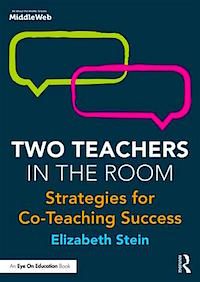Tips for Awakening the Thinkers in Your Room
A MiddleWeb Blog
 So here’s a question: How do you influence your students’ experiences for connecting with themselves as learners on a deeper level?
So here’s a question: How do you influence your students’ experiences for connecting with themselves as learners on a deeper level?
Don’t just read on…or answer with an automatic, generic response. Really think about it. Go make a cup of tea or, better yet, jot the question down on a sticky note and go for a walk, or find a quiet space to allow the freedom of personal, streaming thoughts.
Take the note with you and let the question sit with you…and really think about it.
Maybe that one question will spark deeper, more refined questions like… What is it like to learn within the time and space allotted in your classroom? How do your attitude, personality, and beliefs about how students learn affect the experiences for your students?
It’s a lot of pressure, right? Just think about how your attitudinal and visible teaching moves impact the students who depend on you to shape their own attitudes and beliefs about themselves as learners. And if you’re co-teaching…make the necessity to reflect on your influence times ten!
A Necessary Shift
Here’s the simple truth. For more than 150 years, pedagogy has been driven by the Industrial Age—with a priority on teacher-centered methodologies with teachers as the key controllers of their content area knowledge conveyor belt. Here’s how it works: Teachers turn on the switch…and the teacher becomes the information giver…while the students remain passive information receivers. Do you notice this happening anywhere? If so, perhaps you are starting to squirm in your seat as you sense where I am going with this.
Think about it…how do students in classrooms today feel as they learn within teacher-centered classrooms? Words like passive, devalued, dependent, and invisible come to mind as students learn to quiet their own thinking down, so they may stay alert to receive and regurgitate the thinking and knowledge of the teacher.
We all know the results of this path. Students learn how to “do school.” We can’t keep doing that. Now it is time to guide students to learn how to learn—and to connect with themselves as they move through their ongoing learning process.
The time is seriously…NOW.
It’s time (actually…way beyond time!) for teachers—and educational systems in general—to shift from the perspective of the traditionally prioritized behaviorist view where stimuli (response pedagogies) define the relationships between teachers and students and students and learning—to the necessary cognitivist perspective where learning is a student-centered, active learning, student engaged process.
Rather than teachers continuing to focus on the content and knowledge that students must learn, in the cognitivist’s classroom students are actively seeking, inquiring, solving, and hearing their own thoughts about what they are learning.

How do you influence your students’ experiences for connecting with themselves as learners on a deeper level?
Tips for Awakening Thinkers in your Room
Activate background knowledge: Make time to connect your students with what they already know about what they are about to learn. And make sure that each learner in the room has the opportunity to connect with their prior knowledge. Use turn and talk or other ways to take an extra minute to stimulate each thinker’s schema.
Provide time and space for Individual Information Processing: Strategies like reciprocal teaching, chunking, drawing quick sketches or diagrams to support content, and using concept maps all serve to provide opportunities for learners to internalize the content while connecting with their own thinking as they monitor their understanding.
Support Memory Skills: Directly teach a variety of guided note-taking strategies. Once a few formats and outlines are explicitly taught, allow students to choose the note-taking format that works for them. Verbal rehearsal, self-talk, and mnemonics serve to strengthen memory. Teachers just need to provide the time for students to apply and personally connect.
Stimulate higher-level thinking skills: Weave in varied questions with Depths of Knowledge (DOK) and Socratic Seminars to empower questioning and deep thinking during any lesson, any grade.
Keep them Moving: Plan for inquiry based learning and project-based learning to keep students’ physical, mental, and emotional selves moving and evolving.
Embed Social Emotional Learning: Research confirms that emotions are a natural part of the learning process. Incorporate strategies that embed social and emotional skills as students learn academic, content-area material.
Design for All Learners: Use a universal design for learning mindset to design instruction that connects with every learner. The UDL Guidelines serve as the tool that keeps the emotions and mental processes of each learner at the center—so that every learner has access to the curriculum in personal and meaningful ways.
Caring about how what, how and why students are thinking
The necessary shift from behaviorist to cognitive perspectives is huge! We live in an age where educators must make it their responsibility to care about what, how, and why their students are thinking!
Like the behaviorist perspective, we observe students’ behaviors—but through the cognitivist lens we take those observations and make inferences that can inform the way we design instruction to connect and engage our students.
Guiding our students to tap into their thinking and emotions as a valued part of the learning process is key to activating the thinkers in our classroom—and more important—for their learning beyond our classrooms.
OK, so one more check in with that sticky note: How do you influence your students’ experiences for connecting with themselves as learners on a deeper level?
And now jot down your thinking in the comment spaces below: How are you empowered—and how do you—EMPOWER?
Looking forward to our conversations and an educational paradigm shift in action!



































